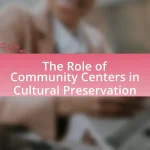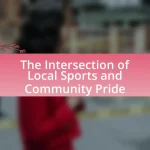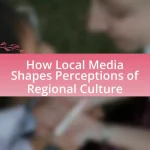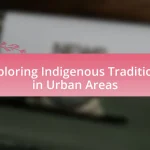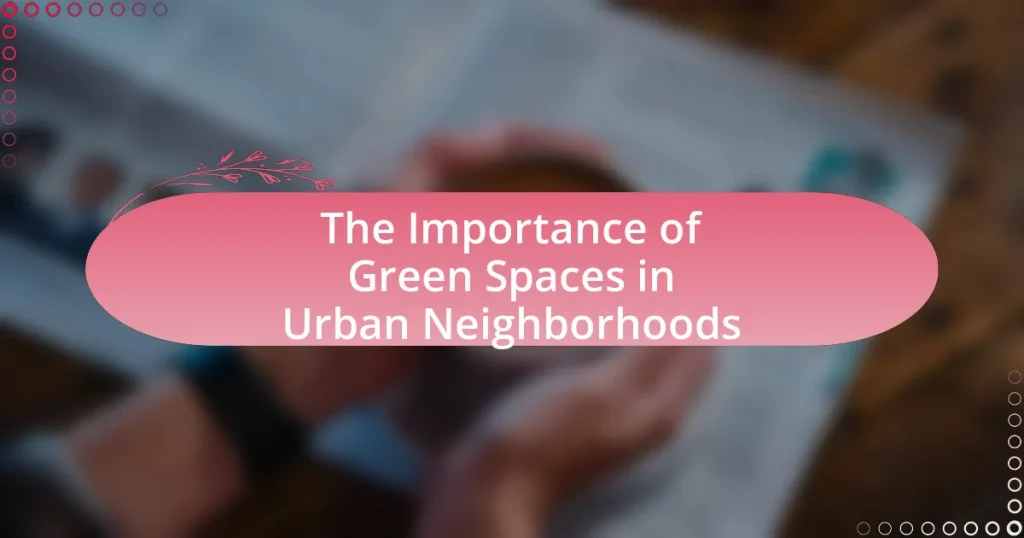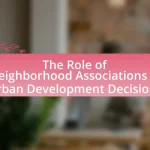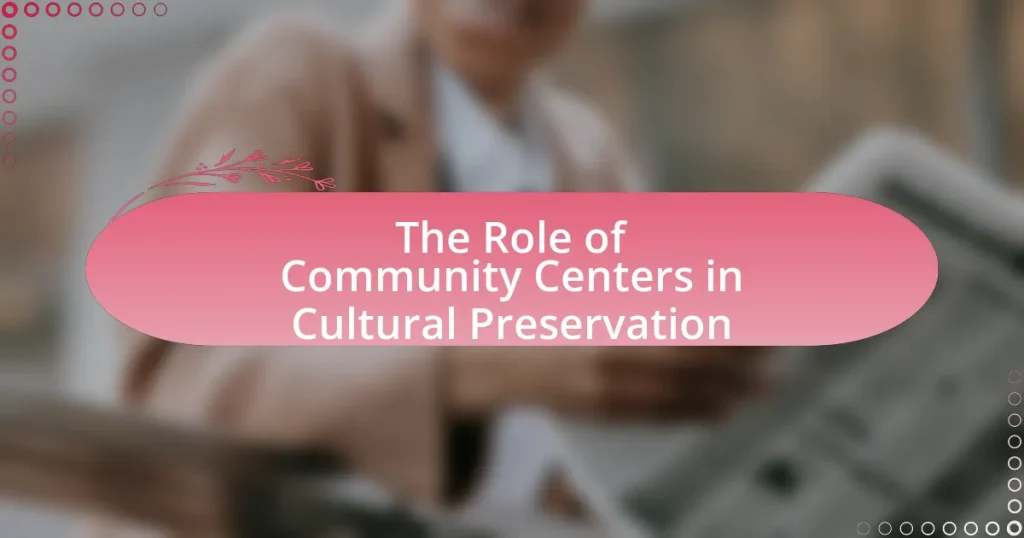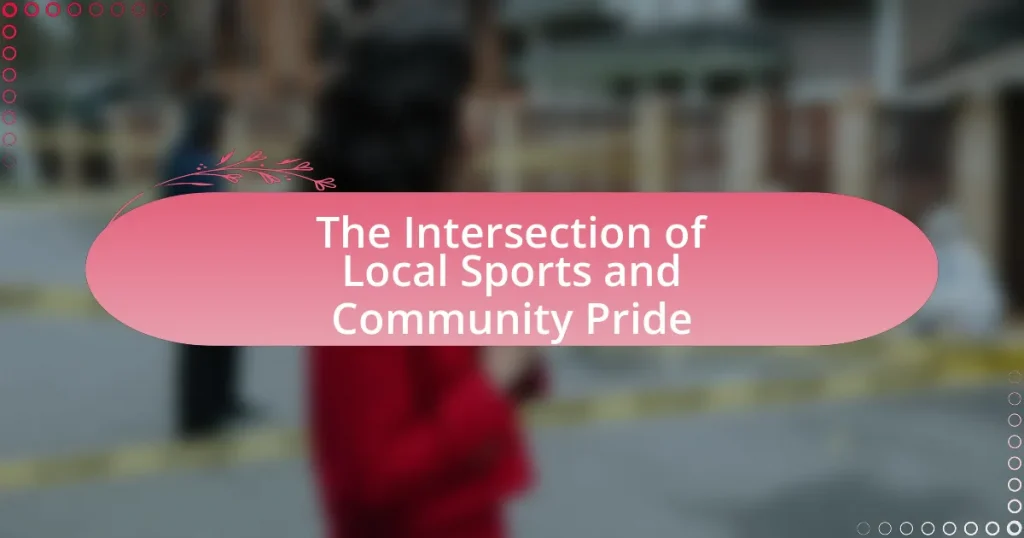Green spaces in urban neighborhoods are areas predominantly covered with vegetation, such as parks, gardens, and greenways, which provide ecological, recreational, and aesthetic benefits. These spaces are essential for improving air quality, enhancing mental health, and fostering community interaction. Various types of green spaces, including parks, community gardens, and green roofs, contribute to urban biodiversity and help mitigate the urban heat island effect. However, challenges such as urbanization, socio-economic disparities, and inadequate maintenance hinder access to these vital resources. Effective urban planning and community involvement are crucial for integrating and sustaining green spaces, which ultimately enhance the quality of life in urban environments.
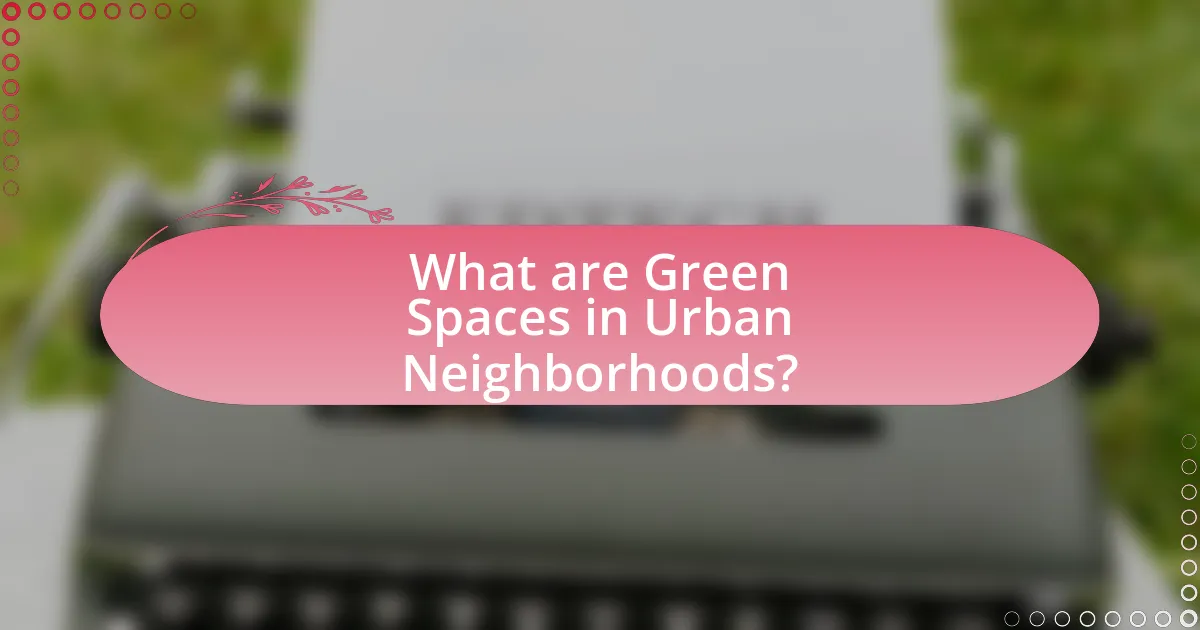
What are Green Spaces in Urban Neighborhoods?
Green spaces in urban neighborhoods are areas that are primarily covered with vegetation, such as parks, gardens, and greenways. These spaces provide essential ecological benefits, including improved air quality, biodiversity support, and temperature regulation. Research indicates that urban green spaces can enhance mental health and well-being, as they offer recreational opportunities and promote social interaction among residents. A study published in the journal “Environmental Science & Technology” found that access to green spaces is linked to lower levels of stress and increased physical activity among urban populations.
How do we define green spaces in urban settings?
Green spaces in urban settings are defined as areas that are predominantly covered with vegetation, including parks, gardens, and natural reserves, which provide ecological, recreational, and aesthetic benefits. These spaces contribute to urban biodiversity, improve air quality, and offer residents opportunities for leisure and social interaction. Research indicates that urban green spaces can reduce heat island effects, enhance mental well-being, and promote physical activity, as evidenced by studies showing that access to parks is linked to lower stress levels and increased community cohesion.
What types of green spaces exist in urban neighborhoods?
Urban neighborhoods typically feature several types of green spaces, including parks, community gardens, green roofs, and street trees. Parks serve as recreational areas for residents, often equipped with playgrounds, sports facilities, and walking paths, contributing to physical and mental well-being. Community gardens allow residents to cultivate plants and vegetables, fostering community engagement and promoting local food production. Green roofs, found on buildings, provide ecological benefits such as improved air quality and reduced urban heat, while street trees enhance aesthetics and provide shade, contributing to biodiversity and urban cooling. These green spaces collectively improve the quality of life in urban settings by promoting health, community interaction, and environmental sustainability.
What characteristics distinguish green spaces from other urban areas?
Green spaces are distinguished from other urban areas primarily by their vegetation, biodiversity, and recreational opportunities. Unlike built environments, green spaces typically feature trees, plants, and open areas that promote ecological health and provide habitats for various species. Research indicates that urban green spaces can improve air quality, reduce heat, and enhance mental well-being, as evidenced by studies showing that access to parks and gardens correlates with lower stress levels and increased physical activity. Additionally, green spaces often serve as community gathering spots, fostering social interactions that are less prevalent in densely built urban settings.
Why are green spaces essential for urban communities?
Green spaces are essential for urban communities because they enhance environmental quality, promote public health, and foster social interaction. These areas improve air quality by absorbing pollutants and providing oxygen, which is crucial in densely populated cities where pollution levels are often high. Studies show that access to green spaces can reduce stress and improve mental health, with research indicating that individuals living near parks report lower levels of anxiety and depression. Furthermore, green spaces serve as communal areas that encourage social cohesion, allowing residents to engage in recreational activities and build relationships, which is vital for community well-being.
What role do green spaces play in enhancing urban biodiversity?
Green spaces play a crucial role in enhancing urban biodiversity by providing habitats for various plant and animal species. These areas serve as essential refuges that support wildlife populations, promote ecological interactions, and facilitate the movement of species within urban environments. Research indicates that urban green spaces can increase species richness; for instance, a study published in the journal “Landscape and Urban Planning” found that parks and gardens can host up to 50% of the species found in natural ecosystems. Additionally, green spaces contribute to ecosystem services such as pollination and pest control, which are vital for maintaining healthy urban ecosystems.
How do green spaces contribute to the mental health of residents?
Green spaces significantly enhance the mental health of residents by providing environments that reduce stress and promote well-being. Studies indicate that access to parks and natural areas is associated with lower levels of anxiety and depression. For instance, research published in the journal “Environmental Science & Technology” found that individuals living near green spaces reported better mental health outcomes, with a 20% reduction in psychological distress linked to increased exposure to nature. Additionally, green spaces encourage physical activity, which is known to improve mood and cognitive function, further supporting mental health.
What challenges do urban neighborhoods face regarding green spaces?
Urban neighborhoods face significant challenges regarding green spaces, primarily due to limited land availability and competing development interests. As cities grow, the demand for housing and commercial spaces often leads to the reduction or elimination of parks and green areas. According to a study by the National Recreation and Park Association, urban areas can lose up to 50% of their green space in the face of urbanization, which negatively impacts community health and biodiversity. Additionally, maintenance and funding for existing green spaces are often inadequate, leading to neglected areas that fail to serve the community effectively. These challenges hinder the ability of urban neighborhoods to provide essential recreational opportunities and environmental benefits.
What factors limit the availability of green spaces in cities?
The availability of green spaces in cities is limited by factors such as urbanization, land use policies, and economic constraints. Urbanization leads to increased population density, which often prioritizes housing and infrastructure over parks and green areas. Land use policies frequently favor commercial and residential development, restricting the allocation of land for green spaces. Economic constraints can hinder the funding and maintenance of parks, as municipalities may prioritize essential services over recreational areas. For instance, a study by the American Society of Landscape Architects indicates that cities with higher population growth often experience a decline in per capita green space due to these competing interests.
How do socio-economic disparities affect access to green spaces?
Socio-economic disparities significantly limit access to green spaces, as lower-income communities often have fewer parks and recreational areas. Research indicates that neighborhoods with higher poverty rates typically lack adequate green space, with studies showing that affluent areas have up to 10 times more parkland per capita compared to low-income neighborhoods. This disparity affects residents’ physical and mental health, as access to green spaces is linked to improved well-being and reduced stress levels. Furthermore, urban planning policies often prioritize wealthier areas, exacerbating the inequity in access to these essential resources.
How can urban planners effectively integrate green spaces?
Urban planners can effectively integrate green spaces by incorporating them into zoning regulations and land-use planning. This approach ensures that new developments include parks, community gardens, and green corridors, which enhance urban biodiversity and improve residents’ quality of life. Research indicates that cities with ample green spaces experience lower urban heat, improved air quality, and increased mental well-being among residents. For instance, a study by the University of Exeter found that access to green spaces can reduce stress and promote physical activity, leading to healthier communities. By prioritizing green spaces in urban design, planners can create sustainable environments that benefit both people and nature.
What innovative strategies can enhance existing green spaces?
Innovative strategies to enhance existing green spaces include implementing vertical gardens, utilizing native plant landscaping, and incorporating smart technology for maintenance. Vertical gardens maximize limited space and improve air quality, as demonstrated by the green walls in urban areas like Paris, which have shown a reduction in urban heat and improved biodiversity. Native plant landscaping promotes local ecosystems and requires less water and maintenance, as evidenced by studies indicating that native plants can reduce irrigation needs by up to 50%. Additionally, integrating smart technology, such as soil moisture sensors and automated irrigation systems, can optimize resource use and enhance the sustainability of green spaces, as seen in cities like Singapore, where smart parks have improved both environmental and user experiences.
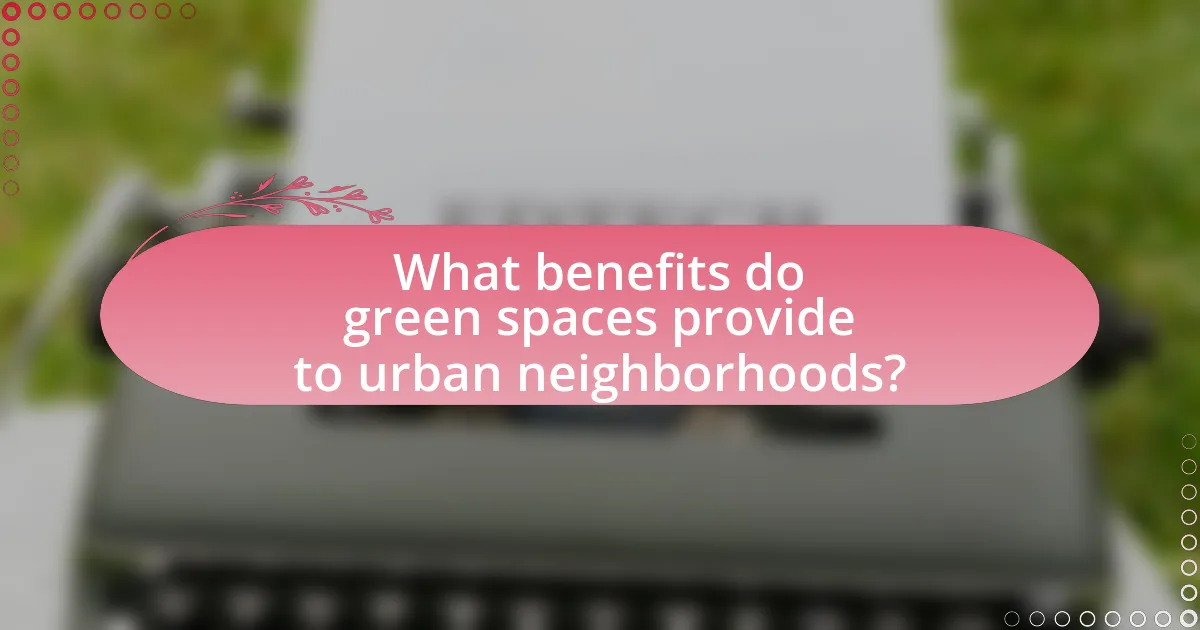
What benefits do green spaces provide to urban neighborhoods?
Green spaces provide numerous benefits to urban neighborhoods, including improved air quality, enhanced mental health, and increased property values. Studies show that vegetation in urban areas can reduce air pollution by filtering harmful particulates, leading to healthier living conditions. Additionally, access to parks and green areas has been linked to lower stress levels and improved mental well-being, as evidenced by research published in the Journal of Environmental Psychology, which found that individuals living near green spaces report higher life satisfaction. Furthermore, properties adjacent to parks often see an increase in value, with a report from the National Association of Realtors indicating that homes near green spaces can sell for 20% more than those further away.
How do green spaces improve air quality in cities?
Green spaces improve air quality in cities by absorbing pollutants and producing oxygen through photosynthesis. Trees and plants filter harmful particles from the air, such as carbon dioxide, sulfur dioxide, and nitrogen oxides, effectively reducing urban air pollution levels. For instance, a study published in the journal “Environmental Pollution” found that urban trees can remove up to 1.7 million tons of air pollutants annually in the United States alone. Additionally, green spaces contribute to lower temperatures through shade and evapotranspiration, which can further reduce the formation of ground-level ozone, a harmful air pollutant.
What specific pollutants are reduced by urban greenery?
Urban greenery specifically reduces pollutants such as particulate matter (PM10 and PM2.5), nitrogen dioxide (NO2), sulfur dioxide (SO2), carbon monoxide (CO), and ozone (O3). Studies have shown that trees and vegetation can absorb these harmful substances, improving air quality. For instance, a study published in the journal “Environmental Pollution” found that urban trees can remove up to 1.7 million tons of air pollutants annually in the United States alone, significantly contributing to cleaner urban environments.
How does vegetation impact urban temperature regulation?
Vegetation significantly impacts urban temperature regulation by providing shade and facilitating evapotranspiration, which cools the surrounding air. Trees and plants absorb sunlight, reducing surface temperatures and mitigating the urban heat island effect, where urban areas become significantly warmer than their rural surroundings. Studies have shown that urban areas with increased tree canopy cover can experience temperature reductions of up to 5 degrees Celsius compared to areas with minimal vegetation. Additionally, the presence of green spaces can enhance air quality and promote biodiversity, further contributing to a healthier urban environment.
In what ways do green spaces foster community engagement?
Green spaces foster community engagement by providing a venue for social interaction, recreational activities, and community events. These areas serve as gathering spots where residents can meet, collaborate, and participate in organized activities, such as farmers’ markets or outdoor concerts. Research indicates that neighborhoods with accessible parks report higher levels of social cohesion and community involvement, as evidenced by a study published in the Journal of Urban Affairs, which found that residents living near green spaces are more likely to engage in community events and volunteer activities. Additionally, green spaces promote inclusivity by accommodating diverse groups, thereby enhancing community ties and fostering a sense of belonging among residents.
How can parks and gardens serve as social hubs for residents?
Parks and gardens serve as social hubs for residents by providing communal spaces that encourage interaction and community engagement. These green spaces facilitate social gatherings, recreational activities, and events, fostering a sense of belonging among residents. Research indicates that neighborhoods with accessible parks report higher levels of social cohesion and community ties, as seen in a study published in the Journal of Urban Health, which found that residents living near parks are more likely to participate in community events and form friendships. Additionally, parks often host organized activities such as farmers’ markets, concerts, and fitness classes, further enhancing their role as vital social centers in urban environments.
What activities can be organized in green spaces to promote community bonding?
Community bonding can be promoted in green spaces through activities such as community gardening, outdoor movie nights, and fitness classes. Community gardening allows residents to collaborate on planting and maintaining gardens, fostering teamwork and shared responsibility. Outdoor movie nights create a relaxed atmosphere for families and friends to gather, enhancing social connections. Fitness classes, such as yoga or group runs, encourage physical activity while building camaraderie among participants. These activities not only utilize the green space effectively but also strengthen relationships among community members, as evidenced by studies showing that shared activities in communal areas lead to increased social interaction and cohesion.
How do green spaces influence property values in urban areas?
Green spaces significantly increase property values in urban areas by enhancing aesthetic appeal and providing recreational opportunities. Studies indicate that properties located near parks and green areas can see value increases ranging from 5% to 20%. For instance, research published in the Journal of Urban Economics found that proximity to parks positively correlates with higher residential property prices, as buyers are willing to pay a premium for access to green environments. Additionally, green spaces contribute to improved air quality and reduced urban heat, further making nearby properties more desirable.
What evidence supports the correlation between green spaces and real estate prices?
Research indicates a positive correlation between green spaces and real estate prices, with properties near parks and green areas typically commanding higher values. A study by the National Recreation and Park Association found that homes located within 500 feet of a park can see property values increase by 20% to 30%. Additionally, a report published in the Journal of Environmental Management highlighted that urban green spaces contribute to increased property values by enhancing neighborhood aesthetics and providing recreational opportunities. These findings consistently demonstrate that proximity to green spaces is a significant factor influencing real estate prices.
How do green spaces affect rental demand in urban neighborhoods?
Green spaces significantly increase rental demand in urban neighborhoods by enhancing the quality of life for residents. Studies show that proximity to parks and green areas can lead to higher property values, with a report from the National Association of Realtors indicating that homes near parks can sell for 20% more than similar homes without such amenities. Additionally, green spaces contribute to lower stress levels and improved mental health, making neighborhoods more attractive to potential renters. This desirability translates into increased demand for rental properties, as individuals and families prioritize access to recreational areas and natural environments in their housing decisions.
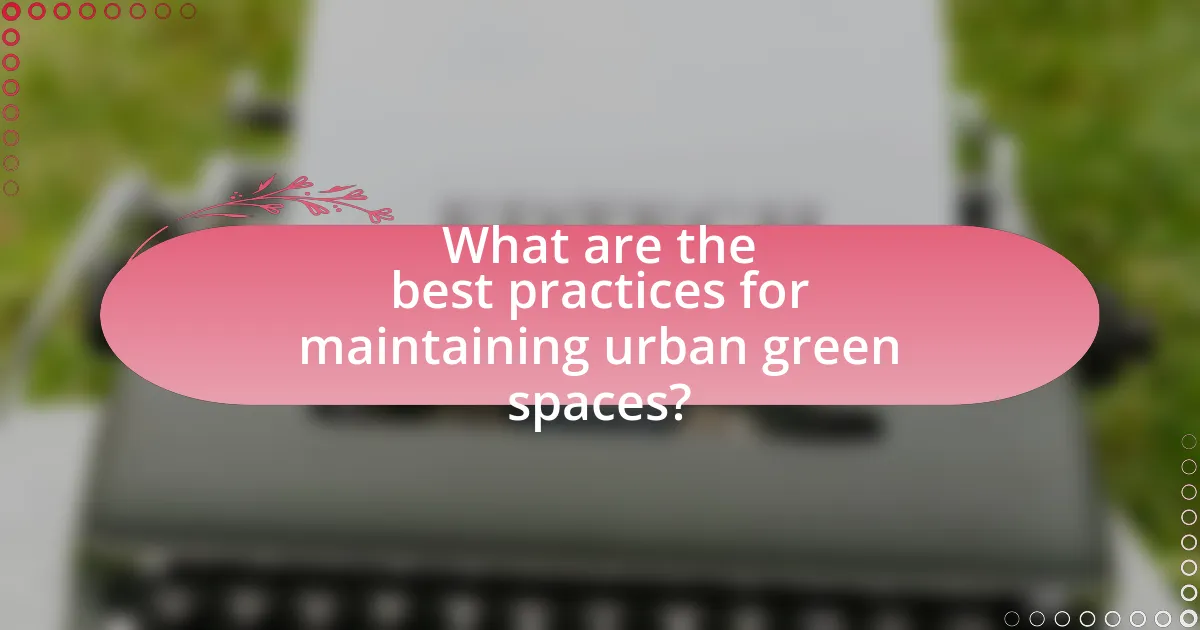
What are the best practices for maintaining urban green spaces?
The best practices for maintaining urban green spaces include regular maintenance, community involvement, and sustainable practices. Regular maintenance involves tasks such as mowing, pruning, and litter removal to ensure the space remains clean and accessible. Community involvement encourages local residents to participate in the upkeep and stewardship of these areas, fostering a sense of ownership and responsibility. Sustainable practices, such as using native plants and implementing efficient irrigation systems, enhance biodiversity and reduce resource consumption. Research indicates that well-maintained green spaces can improve urban air quality and provide mental health benefits, reinforcing the importance of these practices in urban neighborhoods.
How can communities actively participate in the upkeep of green spaces?
Communities can actively participate in the upkeep of green spaces by organizing volunteer clean-up events, planting trees and flowers, and establishing community gardens. These activities foster a sense of ownership and responsibility among residents, leading to improved maintenance and care for local parks and gardens. Research indicates that neighborhoods with active community involvement in green space maintenance experience higher levels of satisfaction and usage, as seen in a study by the University of Illinois, which found that community-led initiatives significantly enhance the quality and accessibility of urban green areas.
What volunteer programs exist for maintaining urban parks?
Volunteer programs for maintaining urban parks include initiatives such as park clean-up days, tree planting events, and community gardening projects. Organizations like the National Park Service and local non-profits often coordinate these programs, engaging community members in hands-on activities that enhance park aesthetics and biodiversity. For example, the “Adopt-a-Park” program allows volunteers to take responsibility for specific areas, ensuring regular maintenance and care. These programs not only improve the parks but also foster community involvement and environmental stewardship, as evidenced by studies showing increased community pride and reduced litter in areas with active volunteer participation.
How can local governments support community-led green space initiatives?
Local governments can support community-led green space initiatives by providing funding, resources, and technical assistance. For instance, municipalities can allocate budgetary funds specifically for community projects that enhance green spaces, which has been shown to increase community engagement and improve local environments. Additionally, local governments can offer access to land, facilitate permits, and provide tools or materials necessary for the development and maintenance of these spaces. Research indicates that cities with supportive policies for community-led initiatives see a 30% increase in successful project outcomes, demonstrating the effectiveness of government involvement in fostering community-driven green spaces.
What role does sustainability play in the management of green spaces?
Sustainability is crucial in the management of green spaces as it ensures the long-term health and viability of these areas. Sustainable practices, such as native plant selection, organic maintenance, and water conservation, enhance biodiversity and ecosystem resilience. For instance, a study by the University of California found that urban green spaces managed with sustainable practices can support 30% more wildlife compared to those that are not. This approach not only improves environmental quality but also promotes social well-being by providing accessible, healthy recreational areas for communities.
How can sustainable practices enhance the longevity of urban greenery?
Sustainable practices enhance the longevity of urban greenery by promoting biodiversity, improving soil health, and optimizing water usage. Implementing techniques such as native plant landscaping increases resilience against pests and diseases, which is crucial for maintaining healthy green spaces. Research indicates that urban areas with diverse plant species experience lower mortality rates among trees, as seen in a study by the U.S. Forest Service, which found that diverse urban forests can reduce the impact of environmental stressors. Additionally, sustainable practices like rainwater harvesting and the use of organic fertilizers contribute to healthier soil, which supports plant growth and longevity. These methods not only ensure the survival of urban greenery but also enhance its ecological benefits, such as air quality improvement and temperature regulation.
What are the benefits of using native plants in urban green spaces?
Using native plants in urban green spaces enhances biodiversity, improves ecosystem services, and reduces maintenance costs. Native plants are adapted to local climates and soils, which means they require less water and fertilizer compared to non-native species. This adaptability leads to lower resource consumption and promotes sustainability in urban environments. Additionally, native plants provide essential habitats for local wildlife, including pollinators, which are crucial for maintaining ecological balance. Studies have shown that urban areas with native vegetation support higher levels of biodiversity, contributing to healthier ecosystems. For example, a study published in the journal “Ecological Applications” found that urban green spaces with native plants had 50% more bird species than those dominated by non-native species.
What practical steps can residents take to advocate for more green spaces?
Residents can advocate for more green spaces by organizing community meetings to discuss the need for parks and gardens. Engaging local government officials through petitions and public forums can effectively highlight community support for green initiatives. Collaborating with local environmental organizations can provide resources and expertise, while participating in city planning meetings allows residents to voice their opinions directly. Research indicates that urban areas with increased green spaces can improve mental health and reduce urban heat, making a strong case for their expansion.
